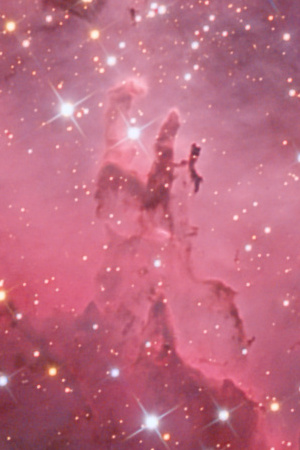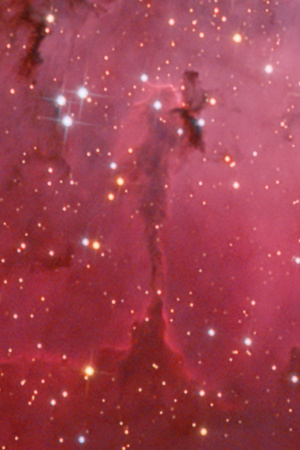The Eagle Nebula, one of the favourite objects of amateur astronomers can be seen in this photo, with the Pillars of Creation in it, a formation made World famous by Hubble Space Telescope. Although the name sounds a bit pathetic, understanding the phenomena happening in those pillars can explain why that name was chosen.
The World famous HST photo
The Pillars of Creation taken by Hubble Space Telescope in 1995 became one of the most well known pieces of astrophotography. Column-like formations of dense gases were seen in the picture, with much more details shown as ever before. The photo created by Jeff Hester and Paul Scowen and the phenomena pictured in it became interesting not only for astronomers but for the general public as well, maybe first time in the history of astronomical imaging. Because of this, the Pillars of Creation is an important milestone of the art of astrophotography.
The man who has discovered Eagle Nebula
The open cluster of stars and the emission nebula seen in this picture was discovered in the mid of 18th century by the Swiss astronomer Jean-Philippe de Chéseaux. In addition to the Eagle Nebula, Chéseaux has discovered seven other nebulae as well, and a couple of decades ahead of Olbers, he was one of the firsts to point out that if the universe were static and infinite with infinite number of stars, the night sky couldn't be as dark as we observe. Still these thoughts are credited to Olbers today.
Charles Messier also listed the nebula in his catalogue as object #16, and in the NGC catalogue it is identified as NGC 6611.
The Eagle Nebula
 The name comes from the appearance of the giant hydrogen cloud observed from Earth, which resembles an eagle. The nebula is a mere 7000 light-years away from the Solar System in the direction of constellation Serpent (the snake). Being so close to us the nebula provides an excellent opportunity for astronomers to study star formation, and other phenomena happening in emission nebulae.
The name comes from the appearance of the giant hydrogen cloud observed from Earth, which resembles an eagle. The nebula is a mere 7000 light-years away from the Solar System in the direction of constellation Serpent (the snake). Being so close to us the nebula provides an excellent opportunity for astronomers to study star formation, and other phenomena happening in emission nebulae.
A lot of stars have formed already from the matter of the cloud, and formation of new stars is still happening in it. According to our current knowledge, there are almost 500 stars in the young open cluster related to the nebula. The brightest star in the cluster is an O type, hot, young blue giant, which is 80 times heavier and a million times brighter than our Sun, and was born only 1-2 million years ago. The remains of the cloud started to shine because of the strong ionising radiation emitted by the young stars. The emission of red light is a property of ionised hydrogen. Some bluish patches can be spotted in the image too, where the dust particles and gas molecules reflect the light of a nearby star.
Young stars interact with surrounding interstellar medium not only by their radiation, but by their intensive stellar wind too, creating a huge bubbles in the gases around themselves, forming the structure of the nebula. The integrated winds of the stars create regions with higher and lower density even flows and walls of gas in the nebula. The Pillars of Creation at the centre of the image, and the Fairy of Eagle Nebula were also formed this way.
The Pillars of Creation and The Fairy of Eagle Nebula
 The wind of the cluster members are blowing away dust and gases from the central region of the nebula. Density of interstellar medium is not homogenous, there are lumps of dense gases all around. These globules act as windbreaks preventing the materials behind them from being swept away. This way column like structures are being formed which point towards the centre of the nebula. The Pillars and the Fairy amongst many others are formed by the same procedure. The temperature and pressure is increasing at the tip of the columns where the lumps are, and also at the whole boundary of the columns, which creates favourable circumstances for star formation. The globules at the tip of the columns are the closest to the hot stars, making them highly exposed to the UV radiation and stellar winds of the stars. These forces slowly but continuously erode them. Astronomers started to call these areas as EGGs (Evaporating Gas Globules), referring to the evaporation of the gases and the formation of new star systems at the same time. The name Pillars of Creation is deserved by the formation of new stars.
The wind of the cluster members are blowing away dust and gases from the central region of the nebula. Density of interstellar medium is not homogenous, there are lumps of dense gases all around. These globules act as windbreaks preventing the materials behind them from being swept away. This way column like structures are being formed which point towards the centre of the nebula. The Pillars and the Fairy amongst many others are formed by the same procedure. The temperature and pressure is increasing at the tip of the columns where the lumps are, and also at the whole boundary of the columns, which creates favourable circumstances for star formation. The globules at the tip of the columns are the closest to the hot stars, making them highly exposed to the UV radiation and stellar winds of the stars. These forces slowly but continuously erode them. Astronomers started to call these areas as EGGs (Evaporating Gas Globules), referring to the evaporation of the gases and the formation of new star systems at the same time. The name Pillars of Creation is deserved by the formation of new stars.
In 2007 the Spitzer Telescope created some images of the region in the wavelength of infrared radiation. Signs of hot gas cloud were identified near the Pillars of Creation. One of the theories explains that as a remnant of a supernova which exploded about 8-9000 years ago, and whose light reached Earth approximately 1-2000 years ago. The shock wave of the hypothetical explosion travelled much slower than the speed of light and it took about a few thousand years to reach the pillars. According to this theory the pillars are already destroyed by the shock wave, but we can't see that. The reason for this is because we are about 7000 years away the object, we can observe it's 7000 years old state only, so an additional few thousand years will have to pass to let the light of the destruction reach Earth, and let us see the results of the destruction. On the other hand, the opponents of this theory pointed out that if there really had been a supernova explosion, we would have measured much higher radio and X-ray emission from the area, which is not the case. They think the high temperature could be caused by the radiation and winds of the young stars in the area.
Either theory turns out to be true, the Pillars of Creation won't last forever, because if not a supernova, then the erosion will destroy them slowly.
